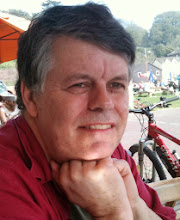I first became aware of his work when I went to Boston, MA to be a participant with Frances M Lynch in the BEAMS Electronic Music Marathon organised by Eric Chasalow at Brandeis University in 2001.
In 2004, he was a performer in the Contemporary Music Network tour Feedback: Order from Noise organised by Knut Aufermann.

To prove that there is no such thing as a free lunch, in return for awarding Mr. Lucier an honorary degree, the payback is the 3-day festival of concerts, exhibitions installations and a seminar.
On Monday, in a concert promoted by Dartington Arts, the Barton Workshop performed in the Great Hall, a splendid 14th century hammer-beamed scheduled Ancient Monument.
Many of the pieces performed explored the relationship of solo instruments (cello, clarinet) playing microtones alongside the slow sweep of recorded pure sign waves generated by an oscillator. As the instrumentalist sustains tuned long tones against the tones, audible beats are created at speeds determined by the distances between the instruments notes and those of the pure waves. The farther apart the frequencies, the faster the beating. At unison no beating occurs. By bending the pitch by few cycles per second, the beating patterns are heard to slow down and speed up. This scientific description of the phenomenon barely touches on the beauty of the resultant pieces. Hear an example for yourself, in the piece Music for piano with slow sweep pure wave oscillators (although not credited on the download site I believe the recording is by Marilyn Nonken from the CD Still Lives Lovely Music LCD 5012).
The following day saw me attending a research seminar where Mr Lucier discussed his recent work and methods of composing. A fascinating insight to a deep and interesting composer.
This was followed by a realisation of one of Lucier’s installation pieces, Music on a Long Thin Wire. It really is that: a long thin wire was stretched diagonally above us in Studio 3 and made to vibrate. To quote from the CD, “A 50-foot length of taut wire passes through the poles of a large magnet and is driven by an oscillator; the vibrations of the wire are miked at either end, amplified and broadcast in stereo. The thin wire is set vibrating four times at four different frequencies; what results is not the low drone one might expect from a long, vibrating wire, but a complexity of evocative, ethereal chords.” An example of what it sounds like can be found here.
The culmination of the 3 days was a performance of Mr Lucier’s seminal I am sitting in a room. This is music, poetry, sound art and scientific investigation all rolled into one. The initial premise is that the performer (in this case, Mr Lucier himself) sits in a room, in front of a mike, reads a short passage of text which is then played back into the room, and then this is recorded, played back, recorded again, again, and again, and again…up to 32 times. The result is that the room resonances affect each subsequent recording such that the text becomes a musical oscillation within the space.

Initially created with 2 tape recorders, this realisation was by sound artist and senior lecturer in music, David Prior. His initial though was to make a Max/MSP patch that alternately looked after playback and recording. However, such is the skill of Mr Lucier to pace his rendition of the original text, all that was needed was a Max/MSP patch to create a 70 second delay. The original text was picked up by an Audio-Techica mike (an A-T 4033, I think) and the output was played into the space by a single Genelec 8020 on a stand. Just to give a little geography of the room – studio 6 is a long thin room, approx 30m long and 10m wide. The reader was place halfway down the room, with his back about 1.5m from the wall, the mic about 05m from his mouth and the speaker pointing at the rear of the mic, Mr Lucier and the wall.
Several people were surprised that the resultant resonant frequencies were not as bass heavy as they were expecting, the room having a length that would suggest the presence of interesting low frequencies. Is this a function of the recording and playback arrangement as much as the influences of the room.? I’m still considering that question.

1 comment:
Paul,
Thanks for the mention (although I am credited on that disc, which also includes gorgeous performance by Joe Kubera). I'll be playing MUSIC FOR PIANO again this February, in New York, and hope to bring it to your side of the pond someday....I think, the world very much needs this music right now.
All best.
Post a Comment